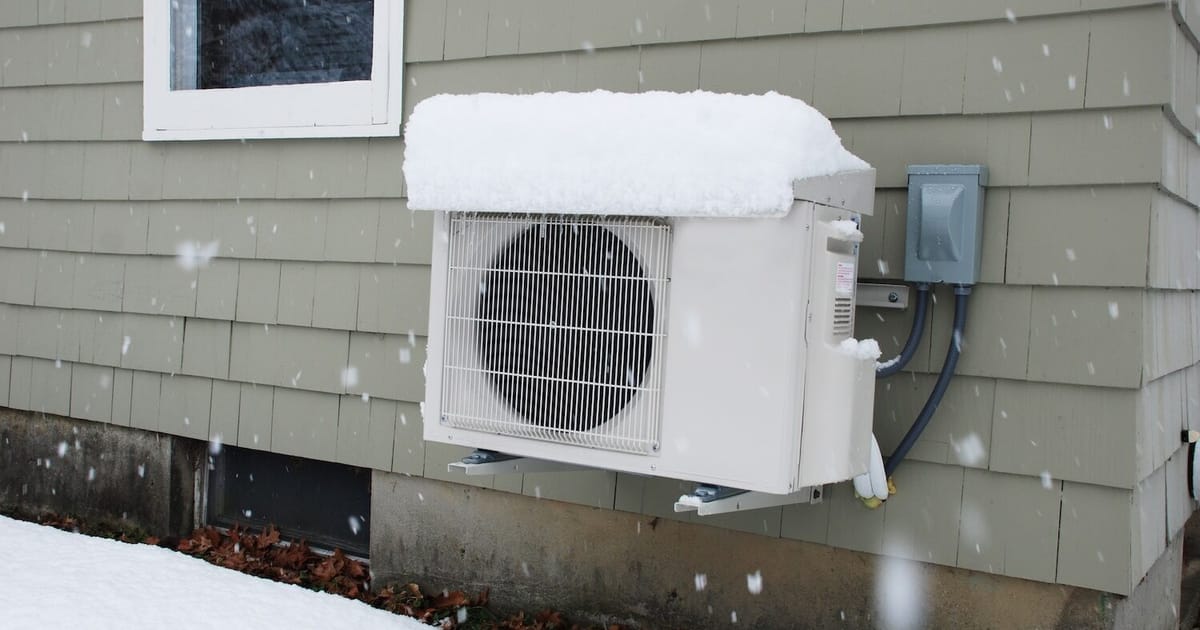- cross-posted to:
- news@chat.maiion.com
- cross-posted to:
- news@chat.maiion.com
Heat pumps sold so fast in Maine, the state just upped its target::undefined
Heat pumps = simply running your AC in reverse
It escapes me such a simple concept could take so long to be considered for homes instead of radiators
It’s a simple idea, but it’s not quite that simple.
When it gets to be around freezing outside, you have to deal with frost buildup on the outdoor unit.
And as temperatures fall, output and efficiency generally falls. So you need an oversized unit to heat your house on the coldest days, but an oversized unit isn’t great the rest of the year.
Historically, heat pumps were only good if it never got down below freezing. Now, modern cold- climate heat pumps are efficient well below freezing and Mitsubishi’s models advertise that they deliver 100% of their output down to -23F/-30C. Between adding variable inverters, better defrosting, etc they’ve come a really long way in the past decade.
deleted by creator
deleted by creator
We have them in Florida. It’s just very cold in the Northern USA.
Lots of houses in the US have heat pumps already.
This is about one state in the far north pushing to get them into more houses. Older heat pumps would not have been very effective there for most of the winter. Newer models can still produce heat in much colder temperatures, so they are adopting them.
Typical naive Australian. What you would consider unbearably frigid is warm by northern standards. It wasn’t until recently that heat pumps were efficient enough to compete with wood and coal furnaces.
Reverse-cycle ACs have had >100% heating efficiency since the 1990s. America just seems to take forever to embrace anything environmentally friendly (reverse-cycle AC, solar hot water, rooftop solar, etc…).
> 100% efficiency doesn’t mean much when you consider that the generation and distribution of electricity is not efficient. It wasn’t until recently that heap pumps became efficient enough to beat onsite burning of fuel.
It wasn’t until somewhere in the last 15 years that air type type heat pumps, as opposed to ground loop, could cope with the cold temperatures in the northern states without having to fall back to resistive heating for weeks at a time.
When you have to run resistive heaters the electrical usage skyrockets and makes a heat pump system vastly more expensive to operate.
If you live in a cold State, Zone 6 or higher, then you need to be careful when purchasing an ASHP to make sure that it has an HSPF of 10 or greater. If it doesn’t then you’ll be paying big electrical bills trying to keep your home warm. Those units are also more expensive to purchase than a regular Heat Pump like you would run down under.
Frankly nowhere in Australia experiences cold anything like what I do on a yearly basis. The coldest temperature ever recorded anywhere in your country was a mere -9f. Here in the United States there’s quite a few places where that is a common daytime high temperature in the winter, even in the lower 48. There’s quite a few places even in Zone 5, see previous map, that will get to -9 and stay there for days at a time.
It’s not uncommon for overnight lows in Zone 6+ to hit -20f and temperatures even lower are definitely possible. At my house in Wyoming last winter we touched -40f / -40c for a some hours one night.
Air type heat pumps simply could not handle those kinds of temperatures until relatively recently. That’s why so much of the US doesn’t have them already. They just didn’t work during the winter in northern half of the country.
When you have to run resistive heaters the electrical usage skyrockets and makes a heat pump system vastly more expensive to operate.
More expensive than a heat pump without a backup/additional electrical resistance heater. Not more expensive than an electrical resistance heater on its own.
That’s what’s so strange about this, in most cases a heat pump would be replacing a non-reversible AC and an electrical resistance heater or gas-fueled furnace. And in nearly every case, even with the need for a backup/additional resistance heater, you’re still saving money. And it’s not like any of this is new technology, it just took forever for it to become popular in the US.
They are completely standard in large parts of the US too–just the northeast and other colder areas haven’t started using them due to their colder winters.
It gets below zero in the north east in the winter. Heat pumps stop working at 20-30F and the system has to switch to classic/emergency heat. They are great for fall/spring (or summer as an AC), but useless for winter.
The bigger issue is that it is extremely expensive to install ductwork, wiring for 1 or more thermostats, and a shiny new heating/cooling system in many existing homes that use classic radiator heat. Depending on where the oil tank is located, it may require removal as well (example: if it is underground, depending on state/municipal laws).
Heat pumps stop working at 20-30F
Yeah crappy ones. This does not apply to the ones designed for cold climates. Mine still beats electric radiators in efficiency at -22f
That’s not necessarily true now the newer systems can go to as low as -15F which in the north only happens for a few hours a year so still a reduction in heating gas/oils needed
…which in the north only happens for a few hours a year…
I know the guy in the TC video used Chicago as an example but the “few hours a year” thing simply isn’t true for many of us.
Where I live we had many days below -15f including a week where itpretty much stayed between -20 and -30 for nearly a week straight.
A Heat Pump will still work, even here, but you need to be careful about which one you purchase and how it handles cold weather.
It’s kind of amazing that with a radiator you turn 1kW of electricity into 1kW of heat energy but with a heat pump depending on the efficiency you might get 2kW of heat or even more with the same amount of electricity.
Not really. Heat pump is not creating heat unlike resistive heater. It’s just transporting it. One must remember even though freezing temperatures are cold for humans, for physics and universe those are still relatively high temperature environment. After all 0 Celsius is 273 positive Kelvin degrees. So that is 273 Kelvin forth of heat to pump around. Well say in -30C, still 243 K worth of heat to pump around. So the issue isn’t is there heat, the issue is the practical mechanical and thermodynamic realities of he pumping. Which in practice comes down to can you find suitable refrigerants with suitable phase change characteristics to pump around.
Which for normal ambient temperatures on Earth is “yes”. Just usually matter of how high pressures one has to use and other nasty features of the materials. For example recently even just CO2 has been started to use more again, issue with it mostly being it has to operate at higher pressures than more traditionally used refrigerants. They just don’t call it CO2 in the bizz, it’s refrigerant fluid R744. That works down to -56.6 Celcius given its triple point temperature. So it won’t heat one in antarctic -80C winter, but for most of Earth even in cold climates -56.6 C is plenty. Problem just is it has to always work under high pressure, since in ambient pressures CO2 just sublimated from solid to gas. Pumping around solid blocks of dry ice isn’t very convient for continuous heat exchange process machine.
Which adds some cost to the pump components. On the other hand… CO2 is pretty darn harmless. As long as concentration locally isn’t too high, humans, animals and plants are perfectly used to handling the gas they exhale. It is non flammable, it is green house gas, but it is green house gas we naturally exhale. Some unit leaking it doesn’t change much, since usually CO2 for industrial use is extracted from waste product gas, that would end up in air anyway.
Plus on need be it can be distilled from air, it’s just energy intensive. Which is why “carbon capture” isn’t a bigger thing. We know how to do carbon capture. It’s just energy intensive and thus on climate impacting massive scale energy prohibitive.
Is this the reason why they’re so expensive?
Just had a 48btu unit installed. 2,000 sqft, 3 - 9k wall units, 1 - 18k ducted unit. Operational down to -22 F.
$20,000 and then a $4,300 rebate and later a $2,000 tax credit. Down right affordable. Would have been even less if new ductwork didn’t have to be retrofitted.
I watched the technology connections video. So I should know. But I don’t really know. What’s the difference between a heat pump and a split air conditioner?
“the” video? He has many on heat pumps. Get watching!
💀
A split air conditioner is will generally have an indoor component (evaporator) and an outdoor component (condenser).
When the compressor runs, the evaporator will get cold and the condenser will get hot.
A heat pump also has a indoor and outdoor components, along with a new item called a reversing valve. The reversing valve allows the system to switch which component is the evaporator and which is the condenser.
When the compressor runs and the reversing valve is enabled, the evaporator is inside and you get cold air.
When the compressor runs and the reversing valve is disabled, the condenser is inside and you get hot air.
Isn’t that what most split AC units are currently capable of? At least I’ve seen them almost all with the ability to produce heat when I was browsing for one.
All of the split units I’ve seen are heat pumps.
Heat pump means that it’s reversible, split package is just the physical arrangement of the pieces.
I am confused. I though heatpumps required you to drill down far underground and pump up warm air while pumping down cold. This article makes is sounds like people are just installing A/C units in backwards. Don’t you need to drill something for heatpumps?
Nah man you’re thinking of geothermal systems. Heatpumps is just an AC that among other things can reverse the cold and hot sides so that it also heats the living area








